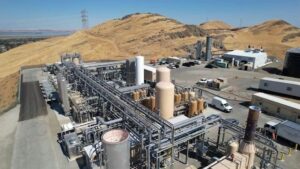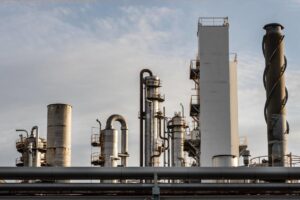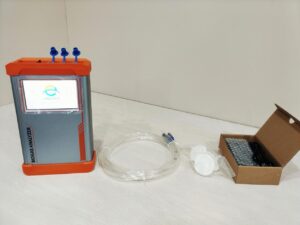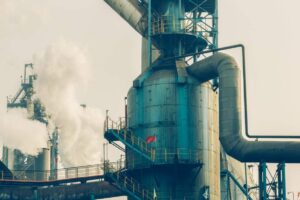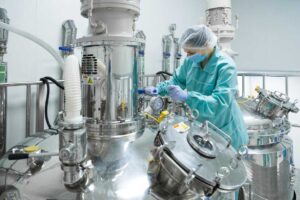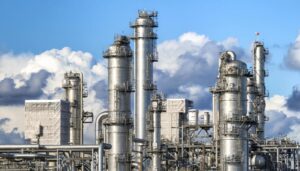Exhaust emissions are unavoidable in modern industrial production processes. Exhaust gases usually contain greenhouse gases such as carbon dioxide (CO₂), carbon monoxide (CO), and nitrogen oxides (NOx), etc. The emission of these pollutants directly contributes to climate change and environmental pollution. With the introduction of carbon neutrality targets, governments and enterprises are gradually realizing the urgency of reducing their carbon footprints.
To effectively control the emission of industrial waste gas, accurate flow monitoring is crucial. An ultrasonic flowmeter has gradually become one of the important tools for industrial waste gas emission monitoring due to its high precision, non-invasive, stable, and reliable features.

The ultrasonic flowmeter is a kind of instrument to determine the flow rate by measuring the time difference of sound wave propagation in the fluid. It is suitable for measuring the flow of various liquids and gases, especially the monitoring of industrial exhaust emissions. Ultrasonic flowmeters can not only help enterprises to accurately control emissions but also provide data support for carbon footprint management and emission reduction strategy, which helps to realize the goal of energy saving and emission reduction.
The Principle and Classification of Ultrasonic Flow Meter
The ultrasonic flow meter is based on sound waves propagating in the fluid by the principle of fluid flow, through the measurement of sound waves in the fluid downstream and countercurrent propagation time difference, the calculation of the fluid flow rate and flow rate. The basic principle can be summarized as follows:

- When ultrasonic waves propagate in the downstream direction, the flow of the fluid accelerates the propagation of the sound waves;
- When propagating in the countercurrent direction, the flow of the fluid slows down the speed of the sound wave;
- By comparing the difference in propagation time in the downstream and countercurrent directions, it is possible to accurately calculate the flow rate of a fluid.
According to the specific measurement and installation methods, ultrasonic flow meter can be divided into the following categories:

- Time-difference ultrasonic flowmeter: the use of ultrasound in the downstream and counter-current direction of the propagation of the time difference to measure the flow rate, suitable for clean gases and liquids.
- Doppler-type ultrasonic flowmeter: By detecting the change of ultrasonic frequency (Doppler effect) to measure the flow of fluids containing suspended solids or air bubbles.
- Clip-on ultrasonic flowmeter: the sensor will be clamped on the outside wall of the pipe, without the need to change the pipeline, suitable for the existing pipeline modification.
- Insertion type ultrasonic flowmeter: the sensor is inserted into the pipeline through the opening, suitable for occasions that require high-precision measurement.
Ultrasonic Flow Meter in Industrial Exhaust Emission Control Applications
Petrochemical industry
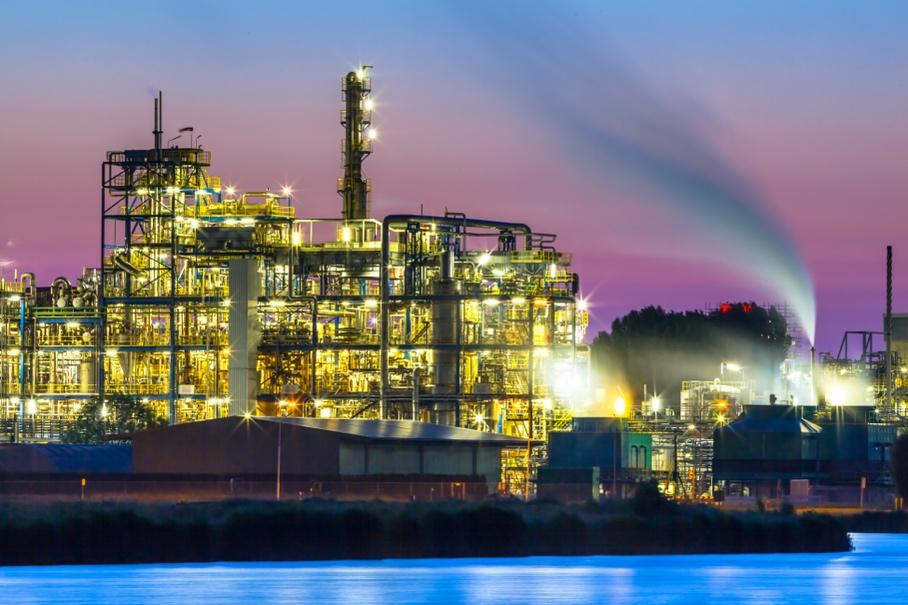
1. Emission control in petroleum refining processes
The petrochemical industry is a significant source of greenhouse gases and harmful emissions. During the petroleum refining process, cracking and distillation generate large quantities of carbon dioxide, carbon monoxide, hydrogen sulfide and other exhaust gases. Because refineries often have large and complex piping systems, precise monitoring of various types of gases is required to ensure that emissions meet environmental standards.
Ultrasonic flow meters are capable of measuring exhaust gas flow with high accuracy, and their non-intrusive nature is ideal for environments in the petrochemical industry where high temperatures and corrosive gases may be generated. Petrochemical companies use ultrasonic flow meter to monitor fuel gas, exhaust gas and flue gas emissions, can real-time adjustment of the combustion system, to avoid too much or too little fuel, to ensure that the combustion of the best efficiency, thereby reducing carbon emissions.
2. Natural gas transportation and handling
In the oil and gas industry, pipeline transportation is the main means of natural gas transmission. Ultrasonic flowmeters are widely used to measure the flow of natural gas, especially at critical nodes such as natural gas compression stations, where accuracy and response speed are critical. Compared with traditional mechanical flow meters, ultrasonic flow meters have no mechanical parts, are not affected by pressure loss, and are able to work stably under high pressure conditions, making them suitable for natural gas transportation and storage scenarios.
Steel manufacturing industry
1. Blast furnace and converter gas emission monitoring
Iron and steel manufacturing is an important contributor to global greenhouse gas emissions, especially during blast furnace and converter operations, where carbon monoxide (CO) and carbon dioxide (CO₂) are the main components of the exhaust gas. The application of ultrasonic flow meter can help enterprises to monitor the flow of waste gas in real time, to ensure the reasonable treatment and effective utilization of waste gas. For example, in the recovery process of blast furnace gas, ultrasonic flowmeter can accurately measure the flow rate of gas, so as to optimize the subsequent gas utilization or discharge.
By monitoring these gases, energy recovery can be realized, e.g. by reusing the exhaust gases as energy in the heating furnace, thus reducing overall energy consumption. Highly accurate measurements help to improve the efficiency of energy use, reduce emissions and ensure that steel companies’ production processes are more environmentally friendly and sustainable.
2. Gas control for sintering and coking processes
In the sintering and coking process, the gas produced often contains a variety of harmful components and suspended particles, and traditional flow meters are prone to clogging or damage in such an environment. The non-contact measurement method of ultrasonic flowmeter can well cope with this challenge, providing stable and reliable data without affecting the gas flow, which provides the basis for the optimized operation of gas treatment plant.
Cement production industry

1. Monitoring of kiln emissions
During the cement production process, especially during the raw material calcination stage, a large amount of carbon dioxide is emitted through the kiln flue. In this type of high temperature and high dust concentration environment, the advantages of ultrasonic flowmeter are particularly prominent. Compared with the traditional mechanical flowmeter, ultrasonic flowmeter can be measured through the outer wall of the pipe, avoiding the direct influence of dust, and can maintain good measurement performance in high temperature and dust environment.
By accurately monitoring kiln exhaust flow, companies can optimize fuel usage ratios, improve combustion efficiency, and reduce fuel waste and unnecessary emissions. In addition, real-time monitoring of exhaust flow helps detect and promptly address equipment abnormalities, avoiding emission overruns due to equipment problems.
2. Optimized control of the combustion process
Combustion control in cement kilns has a decisive impact on production efficiency and emission levels. The real-time monitoring data from the ultrasonic flow meter supports the combustion control system, and by adjusting the amount of combustion air and fuel supply, it can make the combustion more complete and reduce the pollutants generated by incomplete combustion. At the same time, the reduced fuel consumption also helps to reduce CO2 emissions, helping to achieve the company’s energy saving goals.
Power industry
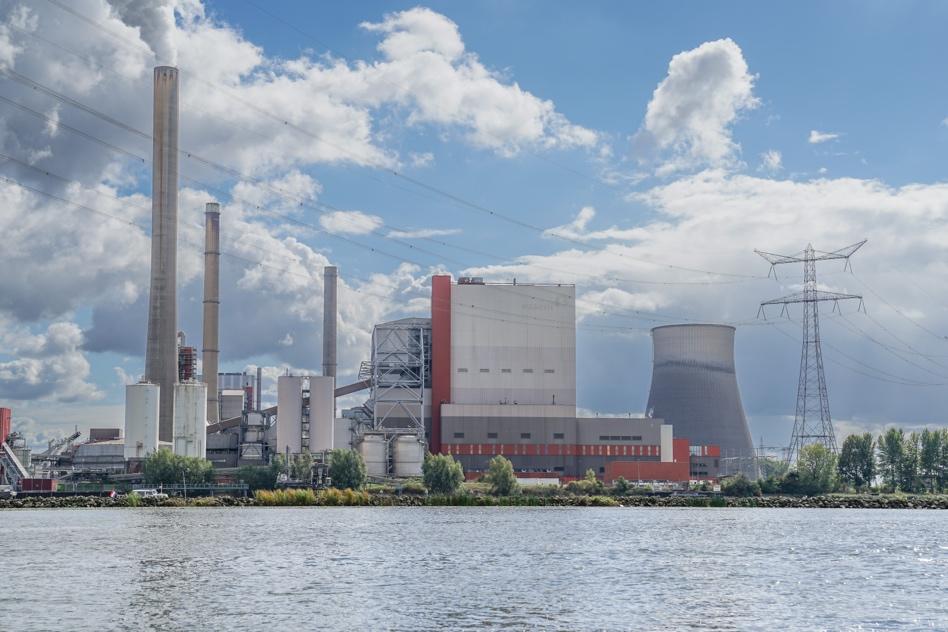
1. Flue gas monitoring in thermal power plants
In thermal power plants, flue gas emissions are an important source of environmental pollution. Burning fossil fuels such as coal and natural gas produces large amounts of carbon dioxide and other harmful gases. Ultrasonic flow meters can be used to accurately monitor the flow of boiler flue gas, provide flow data support for desulfurization, denitrification and other exhaust gas treatment devices, ensure the efficient operation of these devices, and reduce the emission of carbon dioxide and other pollutants.
In addition, ultrasonic flowmeters are able to monitor parameters such as flue gas flow rate and temperature, helping to optimize the combustion process, reduce fuel consumption and lower carbon dioxide emissions. For example, in gas turbine power plants, the precise control of fuel gas is very important to improve combustion efficiency and reduce pollutant emissions, and ultrasonic flowmeter data can achieve real-time control of fuel gas and optimize energy use.
2. Natural gas metering for gas-fired power plants
In the gas power generation process, natural gas is the main fuel, and the accurate measurement of its flow is crucial for the improvement of power generation efficiency. Ultrasonic flowmeter can achieve high-precision measurement of natural gas flow, and due to its low-pressure loss characteristics, it can maximize the fuel utilization rate. This not only helps to reduce carbon dioxide emissions, but also reduces fuel costs and improves the economic efficiency of power plants.
Ultrasonic Flowmeter Contribution in Reducing Carbon Footprint
Improve measurement accuracy and reduce carbon emissions
Ultrasonic flowmeter’s high-precision measurement capability enables enterprises to more accurately control emissions, so as to optimize production processes and reduce resource waste. For example, in the combustion process, ultrasonic flowmeter can help adjust the ratio of air and fuel, so that the combustion is more complete, reduce incomplete combustion of greenhouse gas emissions.
Low energy consumption and long life
Compared with other types of flowmeter, ultrasonic flowmeter is characterized by low energy consumption and long life. Its non-invasive measurement method makes the meter will not be in direct contact with the gas, so it is less susceptible to gas corrosion, reducing maintenance and replacement frequency. This not only reduces operating costs, but also reduces resource consumption due to meter replacement, indirectly reducing the carbon footprint.
Helping companies manage their carbon emissions
With the goal of carbon neutrality, many companies need to manage and report on their carbon emissions. The accurate data provided by ultrasonic flow meters provides an important basis for quantitative management and monitoring of carbon emissions. With this data, companies can carry out accurate accounting of carbon emissions, develop more effective carbon reduction plans, and then gain revenue in the carbon trading market.
Advantages and Challenges of Ultrasonic Flow Meter
Advantages of ultrasonic flow meters
- High accuracy and reliability: ultrasonic flowmeter can provide highly accurate flow measurement results in complex industrial environments, the measurement error is usually within ± 1%.
- Non-intrusive measurement: ultrasonic flowmeter does not require direct contact with the measured medium, to avoid damage to the instrument due to gas corrosion or high temperature environment, suitable for a variety of industrial sites.
- Low Maintenance Requirements: Because the ultrasonic flowmeter has no mechanical moving parts, it has low maintenance requirements, reducing the operating costs of the enterprise.
Ultrasonic flowmeter challenges in applications
- Influence of harsh environments: In environments where there is a lot of noise, vibration, suspended particles or uneven gas flow, the propagation of ultrasonic signals may be affected, leading to a decrease in measurement accuracy. Therefore, in practical applications, the measurement environment needs to be properly optimized and compensated.
- Limitations of the installation conditions: To ensure measurement accuracy, an ultrasonic flowmeter on the length of the straight section of the pipe and the installation angle has certain requirements, which may be more difficult to realize in some of the installation conditions of the industrial site restrictions.
Conclusion
Ultrasonic flowmeter has become an important tool in the monitoring and control of industrial exhaust emissions due to its high precision, non-invasive, stable and reliable characteristics. In industrial exhaust emissions control, the application of ultrasonic flowmeter not only helps enterprises to realize the accurate monitoring of emissions, but also provides important data support for carbon emissions management and carbon footprint reduction.
Through the use of ultrasonic flow meters, companies can monitor real-time emissions, optimize production processes, reduce energy waste, and ultimately achieve the purpose of reducing carbon footprint. In the future, with the deep development of intelligent and Internet of Things technology, ultrasonic flowmeter will continue to play an increasingly important role in the field of industrial emission reduction and environmental protection, in order to achieve the global goal of carbon neutrality to contribute.










